Urban Real Estate Development Trends in Dubai
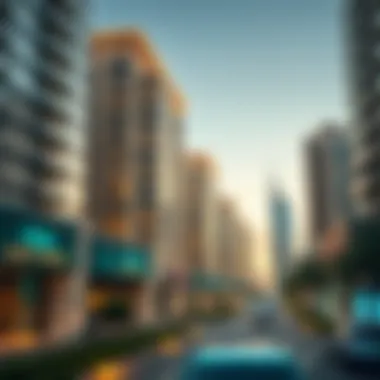
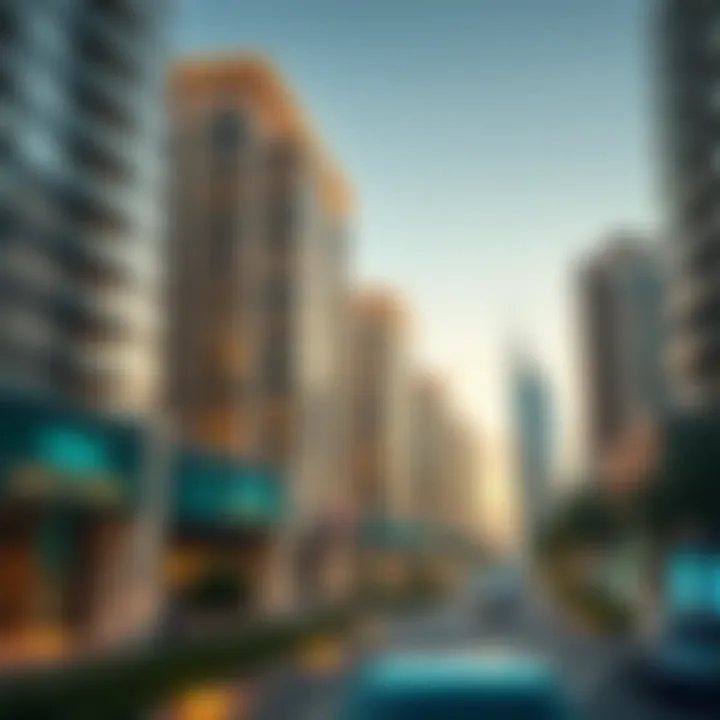
Intro
Dubai's urban real estate scene is nothing short of a grand tapestry woven with ambition, innovation, and rapid transformation. As a city that once featured vast stretches of desert, it has metamorphosed into a bustling metropolis, attracting investors and buyers from every corner of the globe. Consolidated urban real estate development serves as the heart of this progress, helping to redefine not only the skyline but also the very essence of urban living.
While it’s easy to think of Dubai as a transient hub built on luxury, there is a compelling complexity to the forces at play. Economic shifts, demographic changes, and a keen focus on sustainability are just a few variables influencing the landscape. Understanding these intricacies can empower stakeholders—whether they are investors, potential homeowners, or property managers—to navigate this dynamic environment effectively.
This article intends to dissect the layers of this phenomenon, uncovering insights into market trends and investment opportunities that arise from such extensive developments. By examining the present state of the market along with future projections, we aim to provide a comprehensive view that resonates deeply with our audience.
Let’s dive into the trends shaping today’s real estate landscape in Dubai.
Understanding Consolidated Urban Real Estate Development
Consolidated urban real estate development is a crucial aspect of any modern city, particularly in a rapidly growing market like Dubai. As the city continues to evolve, understanding the forces behind its urban landscape becomes essential. This section aims to explore what consolidated urban real estate development really means and its importance in shaping the city's future.
Definition and Scope
At its core, consolidated urban real estate development refers to the strategic planning and construction of real estate projects that aim to optimize resources while maximizing housing and commercial opportunities. This concept encompasses a wide range of configurations, from mixed-use developments to high-density housing, all designed to create vibrant communities that meet diverse needs.
Some of the benefits include:
- Efficient Land Use: By consolidating development, cities can minimize urban sprawl and ensure that land is used in a manner that supports infrastructure.
- Economic Viability: Concentrated development can attract investors, as higher density often leads to enhanced economic activity.
- Enhanced Accessibility: With better planning, transportation and amenities become more accessible, reducing commute times and improving overall quality of life.
Understanding this concept isn't just for urban planners; it matters for investors, buyers, and property managers who are navigating the complexities of the real estate market in Dubai.
Historical Context
Examining the historical trajectory of urban development in Dubai reveals the transformation from small fishing communities to a global metropolis. The boom in real estate during the late 20th century prompted various initiatives to consolidate and diversify the urban landscape. The launch of iconic projects such as the Burj Khalifa and the Palm Jumeirah reflects a shift in priorities towards opulent, innovative designs that attract tourism and foreign investment. Over the past two decades, the framework for urban development has evolved, often at a rapid pace, adapting to changing needs and market dynamics.
It is worth noting the shifting regulations, which have facilitated foreign investments and the influx of expatriate populations, further shaping Dubai's urban identity.
Global Trends
As cities across the globe deal with the challenges of urbanization, Dubai's approach to consolidated development offers valuable insights. Among global trends influencing urban real estate development, three stand out:
- Sustainability Focus: Cities are increasingly prioritizing eco-friendly practices within development projects to combat climate change. Dubai showcases this by integrating green building practices and smart city frameworks.
- Technological Integration: The rise of technology in real estate, from smart homes to PropTech services, has transformed how properties are developed and managed, making projects more efficient.
- Mixed-Use Developments: A growing trend is the development of spaces that serve multiple purposes—housing, retail, and entertainment all in one area. This trend not only enhances the community feel but also boosts economic activities by pulling in foot traffic.
By viewing these global practices through the lens of Dubai's market, it's possible to glean what the future may hold for its urban landscape.
Economic Influences on Development
Understanding the economic influences on urban real estate development in Dubai is crucial for several reasons. This region, often seen as a desert turned into a bustling metropolis, gains its unique character from various economic factors that shape its growth. The essence of these economic influences can be broken down into three major sub-categories: market dynamics, investment drivers, and the impact of global economic conditions. Together, they paint a detailed picture of the opportunities and challenges in the city's real estate sector.
Market Dynamics
Market dynamics in Dubai offer a fascinating blend of high demand and competitive supply. Several elements mold this ongoing evolution:
- Supply vs. Demand: The rapid urbanization in Dubai has led to a surge in property development. A keen observation reveals that when new areas sprout, such as Dubai Marina or the forthcoming Dubai Creek Harbour, they tend to draw in both investors and homebuyers eager to capitalize on the growing value. However, as demand fluctuates, so do the prices, making market fluctuations akin to a rollercoaster ride.
- Rental Yields: The rental market shines in the emirate. High rental yields compared to many global mega cities like London or New York can entice investors. Some may find themselves in a situation where investing in Dubai’s real estate becomes more appealing than other markets, particularly when properties generate higher returns.
- Local Financing: Access to local financial institutions offering favorable mortgage rates has turned the landscape in favor of property owners. More buyers are entering the market, despite rising property prices, thanks to enticing financing solutions.
This synergy of factors creates an environment ripe for development while also demanding insight and tact from investors to navigate these evolving waters.
Investment Drivers
When speaking about investment drivers in Dubai, one can’t overlook the convergence of multiple enticing elements:
- Economic Policies: The government promotes foreign investment, ensuring ease of doing business. Many investors find the relaxed policies welcoming, encouraging them to plunge into the bustling property market.
- Infrastructure Development: Elite projects like the Dubai Metro and improvements in public transport foster connectivity. These infrastructures don’t just ease commutes but also boost property values in nearby areas.
- Taxation Benefits: The absence of income tax and a favorable regulatory landscape functions as a beacon for investors. They find themselves attracted to a setting where profit retention is more attainable.
Moreover, international events like Expo 2020 amplify this drive, attracting tourism and creating short-term property rentals.
Impact of Global Economic Conditions
Global economic conditions reverberate through Dubai’s real estate development in profound ways. As a city heavily intertwined with the global market, its economy dances to the tune of international currents:
- Geopolitical Tensions: Conflicts in distant lands can affect investor sentiment, leading to a hesitant approach towards investment. When risk is perceived on a global scale, money can flee to perceived safety, affecting demand in Dubai.
- Fluctuation in Oil Prices: As a city largely bolstered by oil revenues, oil price swings can create ripples through the economy. For instance, a slump in oil prices may tighten government budgets, affecting infrastructure projects, which could trickle down to hinder real estate growth.
- Interest Rate Changes: Movements in global interest rates significantly shift the landscape for property buyers. A rise in rates can erode affordability, resulting in reduced borrowing and subsequently fewer purchases in the real estate market.
In summary, comprehending economic influences isn't merely a beneficial add-on but rather a necessity for stakeholders in Dubai's urban real estate market. As the sands shift, those who monitor these elements closely will find themselves better equipped to navigate the landscape.
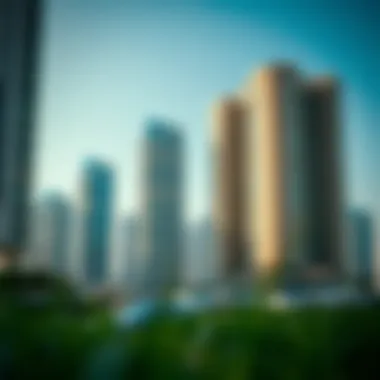

Demographic Changes and Their Impact
Demographic changes significantly shape urban real estate development in Dubai. The city stands out as a melting pot of cultures, driven largely by a robust expatriate population and a steady influx of new residents. These shifts not only influence housing demand but also provoke innovations in development strategies and community planning. Understanding these dynamics is essential to making informed decisions as an investor, property manager, or potential homeowner.
Urbanization Trends
Dubai’s rapid urbanization is not merely a trend but a defining characteristic of its identity. The migration of individuals seeking better economic opportunities has led to skyrocketing urban growth. According to the Dubai Statistics Center, the population has doubled over the past two decades, pushing infrastructure and real estate to evolve at a breakneck pace.
As more people flock to the emirate, land scarcity becomes a pressing issue, prompting developers to adopt consolidated urban development models. This not only maximizes land use but also fosters sustainable communities, accommodating various lifestyles. Here are some key points regarding Dubai's urbanization:
- Increased High-rise Developments: The skyline transforms as more skyscrapers arise, catering to both residential and commercial needs.
- Mixed-Use Projects: These developments promote a live-work-play lifestyle, which has become increasingly popular among younger generations.
- Smart City Initiatives: Urban planning integrates technology to enhance livability and efficiency, appealing to tech-savvy residents.
The ongoing urbanization trend is poised to create more interconnected neighborhoods, changing the fabric of community living in Dubai.
Expatriate Influence
Expatriates constitute a significant portion of Dubai's demographic landscape, contributing not just to the workforce but also to the cultural diversity that defines the city. The allure of Dubai lies in its cosmopolitan lifestyle, drawing individuals from various backgrounds. This transformation results in various cultural influences on the housing market, making it essential for developers to cater to the nuanced needs of this demographic.
- Diverse Housing Needs: Expatriates often prefer different types of accommodations, leading to a burgeoning market for luxury apartments and furnished rentals.
- Cultural Amenities: Developers are adding features like community centers that celebrate multicultural events, attracting a diverse population seeking both comfort and connection.
- Investment Motivation: Many expatriates are investing in real estate as a long-term strategy, buoyed by the lack of income tax and potential for capital growth.
Understanding the expatriate influence helps tailor real estate offerings to meet burgeoning demands, ultimately boosting the market's overall health.
Consumer Preferences
Shifting consumer preferences reflect broader socioeconomic trends affecting real estate in Dubai. The influx of millennials and Gen Z residents rewrites the script on what housing means. More than ever, sustainability, connectivity, and community amenities matter. This demographic desires not just a place to live, but a lifestyle that resonates with their values.
Developers need to pay attention to these preferences:
- Sustainability Matters: Eco-friendly features in buildings are increasingly sought after, as consumers look to minimize their environmental footprint.
- Community-oriented Spaces: Access to parks, recreational areas, and social hubs is paramount, steering development toward community-centric designs.
- Ease of Connectivity: Proximity to public transport and major thoroughfares is essential, as people prioritize accessibility for commuting and their social lives.
The real estate market in Dubai must evolve in tune with consumer expectations. As the landscape changes, insights into these preferences will be vital for successfully engaging potential buyers.
In summary, demographic changes serve as the pulse of urban development in Dubai. Awareness and adaptation to trends, expatriate influences, and shifting consumer preferences are key to thriving in this dynamic market.
Regulatory Framework Surrounding Development
In the multifaceted world of urban real estate, the regulatory framework often acts as the backbone of development. A solid understanding of these regulations is crucial for investors, property managers, and buyers alike. It shapes the landscape in which urban developments happen, influencing everything from project viability to long-term sustainability. Without a grasp on the regulatory environment, stakeholders risk navigating a minefield of compliance issues and missed opportunities.
Government Policies
Government policies play a significant role in steering urban real estate development in Dubai. The local authorities have initiated several policies to bolster investor confidence, stimulate growth, and address the challenges of rapid urbanization. One prevalent example is the Dubai Urban Master Plan, which sets the strategic vision for the emirate by focusing on sustainable development and efficient land use.
Additionally, the government has introduced programs aimed at attracting foreign investments, such as the Golden Visa for long-term residency, which encourages international investors to partake in Dubai's real estate market. This leveling of the playing field, making it more accessible for global players, subsequently enhances the vibrancy of the market.
However, these policies also necessitate close attention to emerging regulations regarding health and safety, environmental standards, and housing quality. The dichotomy between encouraging growth and ensuring compliance lays critical groundwork for developers when initiating projects. As such policies change, they can create ripple effects ranging from shifts in public perception to financial implications.
Legal Considerations
Navigating legal considerations in urban development cannot be overstated. The legal framework surrounding property rights, lease agreements, and ownership regulations in Dubai is unique and varies significativamente compared to other global cities. Key laws, such as the Dubai Property Law and Strata Law, establish the rules for ownership and management of properties, especially in larger developments like those found in Dubai.
It's critical to understand freehold and leasehold distinctions. Freehold properties grant complete ownership to the buyer, whereas leasehold properties offer ownership for a specified period, often 99 years. Misinterpreting these terms can lead to costly mismatches in expectations and reality.
Additionally, developers must be wary of contractual obligations that can arise during joint ventures or partnerships. Due diligence here is paramount; the consequences of neglecting legal considerations can result in unfavorable dealings or conflicts that impede project timelines or, worse, lead to lengthy litigation processes.
Zoning Regulations
Zoning regulations are designed to organize urban growth and ensure that different land uses coexist harmoniously. In Dubai, these regulations limit what can be built in specific areas, which can significantly impact a developer’s vision. For instance, areas designated for residential use may not allow for commercial projects, and vice versa.
Recent zoning reforms have been introduced to better accommodate mixed-use developments, thereby allowing for integrated urban living spaces. This can include combining apartments, offices, and retail spaces within the same project. However, developers must remain vigilant and align their project proposals with the city’s zoning goals.
Moreover, it is not uncommon for zoning laws to be subject to change as the city evolves. Understanding historical zoning practices can give insights into future development opportunities and help navigate challenges that arise in specific neighborhoods.
"A sound regulatory framework not only safeguards investors but also shapes the urban fabric of Dubai, ensuring developments are beneficial for both present and future generations."
In summary, grasping the regulatory framework surrounding urban real estate development in Dubai is not just a legal requirement; it's a strategic advantage. By understanding government policies, legal parameters, and zoning regulations, stakeholders can make informed decisions that lead to successful and sustainable projects.
Sustainability Considerations in Real Estate Development
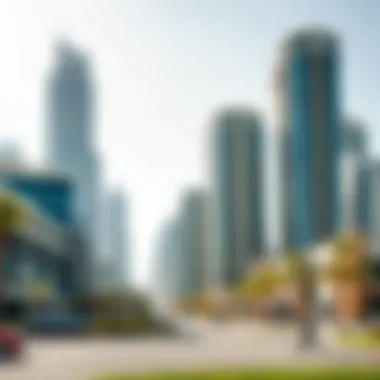

Sustainability is not just a buzzword in today’s urban landscape; it's a critical aspect of real estate development, particularly in a booming market like Dubai. As the city continues to evolve, integrating sustainable practices has emerged as a primary concern for developers, investors, and residents alike. The drive towards construction that respects and enhances the environment is rooted in both market expectations and regulatory demands. By focusing on sustainability, developers can offer eco-friendly solutions that meet contemporary challenges and create long-term value.
Eco-friendly Practices
Eco-friendly practices in real estate development encompass a wide range of strategies aimed at reducing the environmental impact of building projects. This includes utilizing sustainable materials, such as recycled steel and sustainably sourced wood, which not only minimize resource depletion but also allow for better waste management. Furthermore, the inclusion of green roofs, porous pavements, and native plants fosters biodiversity and helps manage stormwater effectively.
Adaptive reuse is another concept gaining traction. Repurposing old structures helps retain the cultural heritage of a city while significantly reducing waste and energy consumption associated with new construction. In Dubai, developers increasingly lean towards such practices, recognizing both the environmental benefits and the market's preference for unique, character-rich properties.
Sustainable Urban Design
Sustainable urban design goes beyond building structures; it encompasses the entire ecosystem of a community. Principles of walkability, mixed-use developments, and efficient public transport are integral in reducing reliance on private vehicles and cutting down carbon emissions. In Dubai, where urban sprawl is a concern, creating compact, pedestrian-friendly neighborhoods is crucial.
The design should also prioritize human experiences, where green spaces, parks, and community facilities are seamlessly integrated within developments. Such designs foster a lifestyle that promotes wellbeing, encouraging residents to lead a more active and community-centered life, while also nurturing a healthier urban backdrop.
Key Components of Sustainable Urban Design:
- Walkability: Streets that favor pedestrians can lead to reduced traffic, improved health, and stronger community ties.
- Mixed-Use Developments: Combining residential, commercial, and recreational spaces minimizes commuting times and enhances convenience for residents.
- Green Spaces: Parks and gardens provide essential ecological benefits while serving as community gathering spots.
Energy Efficiency Standards
Adhering to strict energy efficiency standards is paramount in modern urban development. In Dubai, new regulations mandate that buildings meet specific energy performance metrics, pushing developers to incorporate advanced technologies. Energy-efficient systems such as LED lighting, high-performance HVAC systems, and smart metering reduce operational costs while significantly lowering energy consumption.
The implementation of renewable energy sources, notably solar panels, is becoming a hallmark of sustainable developments. As the sun shines almost year-round in Dubai, harnessing solar power is an economically viable and environmentally friendly solution. Efficient insulation and glazing also play a crucial role, maintaining optimal indoor temperatures and reducing the need for heating and cooling.
Energy efficiency can significantly enhance a building's market value while appealing to eco-conscious buyers.
In summary, sustainability considerations in urban real estate development are not merely optional but essential. By adopting eco-friendly practices, embracing sustainable urban design, and complying with energy efficiency standards, the future of Dubai's urban landscape can be both prosperous and environmentally responsible.
Technological Innovations in Urban Development
Technological innovations have shifted how urban development unfolds across the globe, and in Dubai, the landscape is changing at a rapid pace. The advent of smart technologies and advanced construction methodologies is shaping the real estate market, which is not only about bricks and mortar anymore. The integration of technology in urban settings brings numerous benefits, enhancing operational efficiency, sustainability, and quality of life for residents. Investors and property managers striving for a competitive edge must recognize the importance of these innovations and how they fit into the larger development narrative.
Smart Technologies
Smart technologies form the backbone of modern urban development. Sensor networks and connected devices contribute to what many are now calling "smart cities." In Dubai, initiatives like Dubai's Smart City project and the implementation of integrated management systems for energy, water, and waste have heralded a new era. These technologies not only improve efficiency but also open doors for better resource management. For instance, smart meters allow property managers to monitor energy consumption in real-time, providing valuable data that can guide more sustainable practices. Investors see this as an opportunity to invest in properties with built-in smart features that appeal to tech-savvy tenants.
Furthermore, technologies like Geographic Information Systems (GIS) enable better planning and development processes by analyzing data patterns. This level of insight ensures that urban planners are making informed decisions, which can lead to higher tenant satisfaction and property value appreciation over the long haul.
Impact of PropTech
PropTech, or property technology, encapsulates a wealth of innovations in real estate ranging from virtual property tours to blockchain for transaction transparency. One significant impact of PropTech in Dubai is the democratization of real estate investment. Platforms that leverage blockchain technology allow a greater number of investors to participate in property ownership at various levels. This opens up avenues that were previously inaccessible for many, expanding the market even further.
Moreover, PropTech simplifies property management by offering cloud-based solutions that streamline processes such as tenant communication, maintenance requests, and rent collection. This can lead to higher operational efficiencies and lower overhead costs, benefiting both property managers and owners alike. Companies in Dubai are increasingly adopting these innovations, positioning themselves as industry leaders in a competitive marketplace.
Future of Urban Living Technologies
The future of urban living is undoubtedly intertwined with technological advancements. Concepts like augmented reality (AR) and virtual reality (VR) are beginning to find their footing in Dubai's real estate sector. Imagine a scenario where potential buyers can take a virtual walk-through of a property from halfway around the world. This not only saves time but also enhances the buying experience, making it easier for clients to envision their new lives.
As cities grapple with challenges such as overcrowding and environmental impact, innovations like Internet of Things (IoT) devices promise solutions. These devices can monitor air quality and optimize traffic flow, making urban living more sustainable. In addition, urban farming technologies are gaining traction, allowing for food production in high-density areas, which is crucial for food security in the years to come.
"Innovation is the secret sauce that will define the cities of tomorrow; those who can harness it will shape the future of urban living."
In summary, leveraging technological innovations is not just an option but a necessity for investors, property managers, and developers in Dubai. Understanding how smart technologies, PropTech, and urban living innovations contribute to enhancing the real estate landscape will equip stakeholders to make informed decisions. Adapting to these changes will ultimately determine success in Dubai's vibrant urban development scene.
For more detailed insights into technological advancements in urban settings, you can explore resources from Wikipedia or Britannica.
Case Studies of Successful Consolidated Developments
Analyzing real-world examples provides invaluable insights into the dynamics of urban real estate development. In the context of Dubai, these case studies highlight what successful projects look like, shedding light on crucial factors influencing their success while also illustrating the challenges faced. By examining specific developments, investors, property managers, and potential homeowners can glean lessons that will inform future decisions and strategies in this rapidly evolving market.
Analysis of Iconic Projects
Dubai is known for its skyline adorned with unique architectural wonders, each telling its own story of ambition and innovation. Let's delve into a couple of iconic projects which epitomize successful consolidated urban development in this vibrant city.
One standout project is Burj Khalifa. This towering structure, standing at 828 meters, isn't just an emblem of luxury; it's a demonstration of what can be achieved when cutting-edge technology marries visionary design. Not only is it the tallest building in the world, but it also combines residential, commercial, and leisure spaces all under one roof, attracting both tourists and investors alike. The Dubai Mall adjacent to it acts as a major retail and entertainment hub, supporting local businesses and providing an influx of visitors. These facets highlight the importance of integrated development—where various functions coalesce to create vibrant urban spaces.
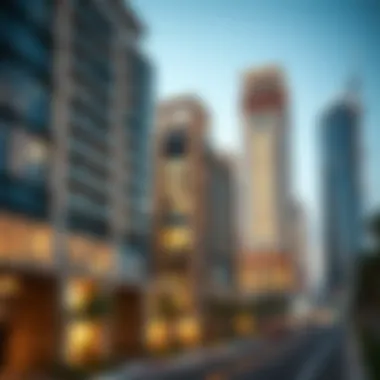
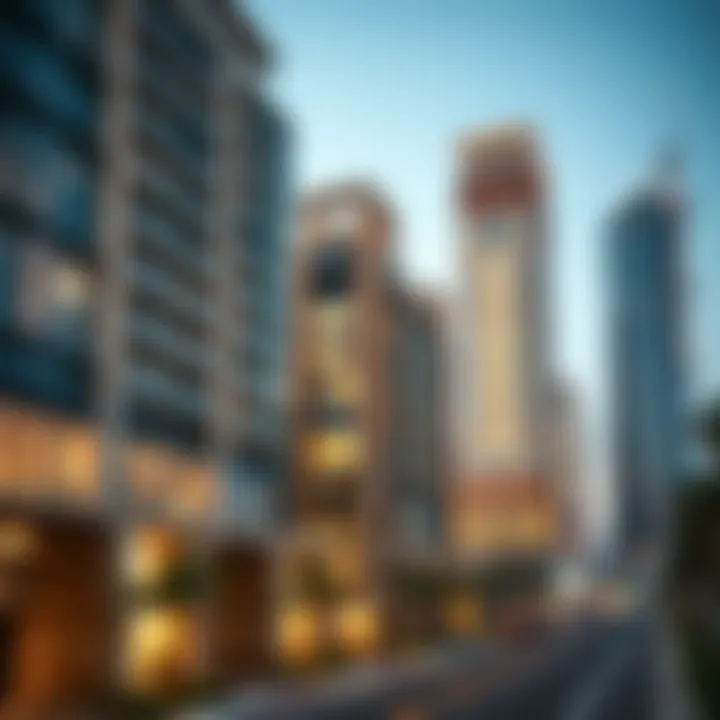
Another project worth mentioning is Dubai Marina, which has transformed an entire area into a livable, vibrant community. The mixed-use development incorporates residential units, workspace, and leisure areas, catering to a diverse audience from expats to tourists. Its accessibility via water taxis and proximity to major transport networks illustrate how thoughtful planning can yield not just aesthetic value but also functional convenience.
Lessons Learned from Failures
As illuminating as success stories can be, they often distort the reality of potential pitfalls. Learning from failures is equally vital to understanding the urban development landscape.
One prime example is the Dubai Waterfront project, which was initially conceived as a vast urban development along the coast. While ambitious, it faced significant setbacks due to the financial crisis of 2008. The disconnected planning and over-reliance on high-end luxury developments without considering market demand led to its stalling. This offers a crucial lesson: the importance of aligning development projects with economic realities and market needs. Projects should not just respond to immediate opportunities but should also anticipate future market fluctuations.
Furthermore, the Al Maktoum International Airport, which was initially set to be the world’s largest airport, encountered budget overruns and delays that led stakeholders to question its viability. While airport expansion remains a necessity, this highlights the need for robust project management and thorough forecasting to avoid overextending resources.
Emerging Projects to Watch
Keeping an eye on upcoming projects can be just as rewarding as studying established ones. They often depict the cutting-edge of trends within urban development.
One noteworthy project is The Dubai Creek Tower, aiming to surpass Burj Khalifa in height. It represents not just an architectural feat, but with its planned mixed-use spaces, it offers an exciting glimpse into the latest trends prioritizing community, culture, and sustainable living. Another fascinating venture is Expo 2020's District 2020, which proposes a transformation of the Expo site into a sustainable urban area, encompassing residential and commercial space designed with the future in mind.
These projects underscore a shift towards sustainable and community-focused developments, moving beyond sheer size and luxury. They indicate an evolving demand from residents for environments that foster well-being and connectivity.
“The story of urban development in Dubai is not just about buildings; it’s about creating experiences that resonate with the community.”
In summary, case studies provide a dual lens through which we can examine the urban real estate terrain in Dubai, from shining successes to Illuminating failures leading towards promising future endeavors. By analyzing these aspects, stakeholders can approach their investments with a sharper insight into the intricacies of this complex market.
Challenges Facing Urban Real Estate Development
The landscape of urban real estate development in Dubai is not without its hurdles. Understanding these challenges is crucial for investors, buyers, and property managers who are navigating this dynamic market. The complexities are multifaceted, comprising economic uncertainties, infrastructure limitations, and social and cultural barriers, each playing a significant role in shaping development outcomes.
Economic Uncertainties
Economic uncertainties pose a considerable challenge to urban real estate development. Factors such as fluctuating oil prices, geopolitical tensions, and global economic downturns can severely impact investor confidence. In Dubai, the real estate market has often mirrored broader economic trends, sometimes leading to volatility in property values. For instance, during periods of economic contraction, demand for residential and commercial units may decline, leading to surplus inventory and decreased rental yields. Investors must keep a keen eye on indicators like GDP growth, inflation rates, and employment stats, not only locally but also globally.
Moreover, the ongoing aftermath of the pandemic has altered buyer behavior and financing options, making the landscape more unpredictable. Developers need to account for these variables in their planning, often requiring a flexibility to adapt quickly to shifting market conditions. An understanding of economic forecasts, along with a robust risk management strategy, becomes indispensable for stakeholders in this real estate arena.
Infrastructure Limitations
The success of urban real estate development hinges heavily on infrastructure quality. In Dubai, while the city boasts impressive modern amenities, there remain pockets where infrastructure is still catching up. Traffic congestion remains a nagging issue, particularly in burgeoning neighborhoods where road networks have not yet been updated. Poor accessibility can deter potential buyers or tenants, affecting property values and rental demand.
Additionally, essential services such as water, electricity, and waste management must evolve alongside rapid urban growth. Delays in infrastructure development can slow down project timelines, inflate costs, and complicate logistics for developers. An analysis of historical data can reveal patterns in infrastructure investment and urban planning, allowing potential investors to assess future risks. Keeping abreast of municipal plans and timelines is vital; prospective buyers are increasingly inclined to favor developments where infrastructure is either present or on the brink of significant enhancement.
Social and Cultural Barriers
Social and cultural barriers introduce a layer of complexity that developers must navigate keenly. Dubai is a melting pot of cultures, with a significant expatriate population influencing housing preferences and community dynamics. However, this diversity can also lead to varying expectations for communal spaces and residential amenities. What appeals to one group might not resonate with another, which can create challenges in marketing properties and ensuring long-term community satisfaction.
Additionally, understanding cultural nuances is essential for any marketing or development strategy. Missteps in addressing cultural sensitivities can resonate poorly, leading to reputational damage that might take time to overcome. Developers should engage with local communities to better understand their needs and preferences, ensuring a more harmonized approach to urban living. Integrating local cultural elements with modern amenities can foster a sense of belonging among residents, thereby enhancing property appeal.
In the realm of urban real estate in Dubai, recognizing and addressing these challenges is not just advantageous; it's paramount to achieving successful and sustainable development.
Future Outlook for Urban Development in Dubai
The evolution of urban real estate in Dubai is not merely a reflection of its architectural grandeur or economic prowess; it encapsulates a profound transition shaped by a myriad of influences. Understanding the future outlook for urban development is crucial for investors, potential homeowners, and policy makers alike. This segment of the article aims to outline predicted trends, investment opportunities, and the shifting demands of consumers as they relate to urban development in this rapidly changing landscape.
Predicted Trends
As the city continues to evolve, several trends are emerging that can shape the future of urban real estate development in Dubai:
- Sustainable Living: Eco-friendly developments are no longer just a selling point but a necessity. Properties that incorporate sustainable technology and design more likely resonate with the environmentally conscious buyer.
- Smart Urban Solutions: The integration of smart technologies within urban infrastructures is expected to surge. This includes IoT applications that enhance the living experience, from energy management to automated systems that improve security and convenience.
- Mixed-use Developments: The trend towards mixed-use spaces, where residential, commercial, and recreational facilities coalesce, is anticipated to gain traction. This promotes a sense of community while optimizing space utilization in the dense urban environment.
The way Dubai approaches its urban development today sets the tone for the living experiences of tomorrow, making it pivotal to stay ahead of the trends.
Investment Opportunities
For investors eyeing Dubai's real estate market, the future holds promising opportunities, particularly in:
- Affordable Housing: The growing population has increased the demand for affordable housing. Developers who can effectively tap into this segment may find themselves at a distinct advantage.
- Luxury Segment: On the flip side, there is an uninterrupted thirst for luxury properties, particularly among wealthy expatriates and investors. High-end developments that promise exclusivity and unique amenities will continue to attract interest.
- Real Estate Investment Trusts (REITs): With the regulatory framework becoming more accommodating, the potential for REITs in the Dubai market could open new avenues for both institutional and individual investors.
Evolving Consumer Demands
The dynamics of consumer preferences are shifting, as reflected in:
- Preference for Flexibility: Potential buyers increasingly favor properties that offer versatility in use. For example, residents are interested in multi-functional spaces that can adapt from living to working environments seamlessly.
- Health and Wellness: In the post-pandemic landscape, consumers are more attuned to health initiatives. Developments that promote wellness, including green spaces and proximity to nature, will resonate with today’s buyers.
- Technological Integration: As consumers grow more tech-savvy, they expect their homes to feature cutting-edge technology. Smart home features are becoming a standard expectation rather than an added luxury.
The future outlook for urban development in Dubai is characterized by a blend of sustainability, technology, and evolving consumer desires, making it an intriguing domain for various stakeholders. Understanding these factors is crucial for navigating the challenges and opportunities that lie ahead.
For further reading on Dubai's urban development, consider exploring Wikipedia, Britannica, and the governmental resources available on Dubai's official page.



